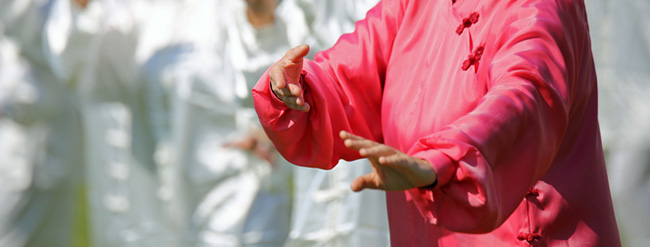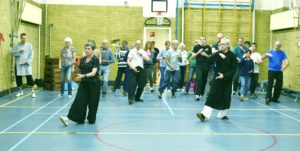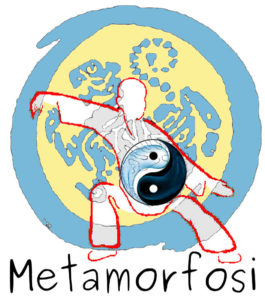Slanted FlyingJournal of Tai Chi Chuan
Training
Is Taijiquan Natural?
 But this is another “natural” tendency that needs to be consciously corrected by our Taijiquan training in order to achieve proper whole-body usage. The conscious correction of “natural” tendencies is a part of the “internal” process that is involved in Taijiquan; we retrain/alter the habitual, instinctive, or “natural” ways of using the body and the mind.
But this is another “natural” tendency that needs to be consciously corrected by our Taijiquan training in order to achieve proper whole-body usage. The conscious correction of “natural” tendencies is a part of the “internal” process that is involved in Taijiquan; we retrain/alter the habitual, instinctive, or “natural” ways of using the body and the mind.
Not that all we do in our training is countering natural tendencies. We want to be comfortable when issuing or receiving force; and this depends on our ability to utilize the natural alignments and strengths (optimal joint angles, etc.) of our bodies. But many people tend to form bad habits that constrain our ability to be “catlike” in our movements. We need to train our bad habits away. Corrections, over time, become movements that can be properly performed without requiring additional mental focus, which can then focus on other aspects of an interaction.
Wang writes (Brennan translation): “Neither going too far nor not far enough, comply and bend then engage and extend.” It may just be a matter of practice in order to gain skill at being just right, but it requires mental awareness to recognize when one is using too much or too little, and when it is appropriate to retreat or advance, when to absorb/bend and when to project/extend, etc. “Once you have engrained these techniques…unless you practice a lot over a long time, you will never have a breakthrough” (Wang, Brennan translation). This again points to the idea that we are retraining ourselves to acquire skills that do not come naturally or quickly.
Wang also writes (Brennan translation): “We often see one who has practiced hard for many years yet is unable to perform any neutralizations and is generally under the opponent’s control, and the issue here is that this error of double pressure has not yet been understood.” “Double pressure” is what we do “naturally” because we instinctively use force against force (we fight against force by using force, and the greater the force that we are resisting, the more force we try to use).
We need to train to “drop one side” so that we are no longer just using force to resist force. Wang addresses this in the following (Brennan translation): “Standing like a scale, move like a wheel. If you drop one side, you can move, but if you have equal pressure on both sides, you will be stuck.” One will be stuck when using the natural tendency to resist, rather than yielding and sticking – without resisting and without collapsing or breaking away.
Wang continues (Brennan translation): “If you want to avoid this error [double pressure], you must understand passive and active. In sticking there is yielding and in yielding there is sticking. The active does not depart from the passive and the passive does not depart from the active, for the passive and active exchange roles.” It is because this is not “natural” that practitioners have such difficulty accomplishing this. This passive and active not departing from each other is different from what happens with the fight-or-flight response where one is either active (fight), or passive (flight), rather than being both active and passive simultaneously (not separating but also not resisting).
Wang also states (Brennan translation): “The basic of basics is to forget about your plans and simply respond to the opponent.” This is also not natural for most of us. We tend to have egos that lead us into wanting to impose our way rather than letting someone else be in charge. Controlling the situation by letting the partner/opponent lead is not easy. Many styles of martial arts teach that the more aggressive person often has the advantage; yet Taijiquan wants us to let the other person take the initiative and lead!
There are many additional examples of having to overcome our natural tendencies. For example, we tend to have a “monkey mind” that is easily distracted such that a calm focus is often difficult. Meditation practices are therefore often beneficial to Taijiquan practitioners. Our minds are also easily distracted and incapable of concentrating on more than one or two things at a time. But interactions with opponents often comprise more than one contact point; one can be distracted by what one hand does while a different part of the body is left vulnerable to a different attack.
Even feints when not in contact with an opponent can distract us from subsequent real attacks. We are easily deceived, and this is what magicians are able to take advantage of. It is no less common to be distracted or deceived when fighting someone. We are bad at multitasking, and have difficulty keeping our awareness on multiple points of contact when interacting with an opponent. If one hand doesn’t get you, then the other will.
Overcoming these mental challenges requires becoming familiar enough with possible situations such that nothing is totally foreign to us us. Taijiquan practitioners are aided in this if they can gain and maintain contact with the opponent. We train to sense with our mechanoreception and proprioception, in addition to our vision, in order to receive additional information about an interaction. With greater awareness, one has the potential for greater understanding.
But one still needs experience to keep from being distracted by additional information that is being received. Once one can subsume distinct skills into an overall sensation/awareness, then one is back to doing one united thing rather than focusing on the numerous component parts. It is because walking and eating have become routine for us that we can “walk and chew gum at the same time,” although texting while driving is still too much.
Taijiquan’s “unnaturalness” is one of its strengths because it is not very familiar to what other styles may be accustomed to. One of the reasons for the development of different martial arts styles is the search for ways to counter what other martial artists can do. This is a common plot in the old Shaw Brothers martial arts films; a hero being defeated and humiliated by some martial style, and then training in some other style that they use to defeat their enemy at the end of the film. We want to use characteristics that are different than what opponents are familiar with (for Taijiquan that is the soft overcoming the hard). One needs to practice being different!












